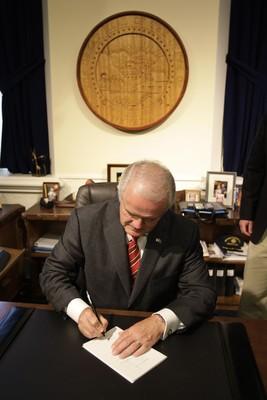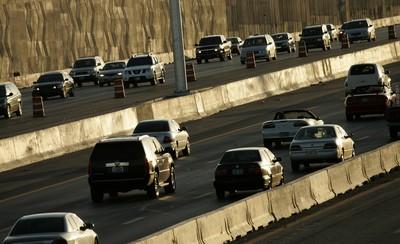I-15 gets budget support
Commuters using Interstate 15 were big winners in Nevada's 2007 Legislature. Not so for everyday drivers on U.S. Highways 95 and 93.
Roughly $1 billion in new highway money set aside by the Legislature virtually ensures the widening of I-15 in the northeast and southwest valley.
But it's unlikely any cash will be left over to add U.S. 95 lanes or build a U.S. 93 bypass around Boulder City. And it's almost certain the needed funds won't be in hand for years to come.
Those projects are among 10 so-called highway "superprojects" statewide, totaling around $6 billion, that the Nevada Department of Transportation deems necessary to head off crippling freeway congestion in the coming years.
Despite the new cash infusion, highway planners are still $4 billion short of being able to pay for the entire superproject list through 2015. Officials hope about half of seven Southern Nevada superprojects will make the cut, among other road work.
The Legislature's failure to fully address the road issue means politicians could find themselves having the same funding debates again in the future.
"The gap's going to get larger. That's the budget consequence," Jacob Snow, general manager of the Regional Transportation Commission, said Tuesday after the end of the 2007 Legislature's regular session. "This issue is going to keep coming up and up until we deal with it in an appropriate fashion."
Nonetheless, the state's highway honchos will take whatever help they can get.
"Getting something is better than getting nothing," said Susan Martinovich, the state's transportation director. "We'll spend every dollar we get. We have far more needs than we have dollars."
The only superproject specifically earmarked for funding is the $210 million widening of I-15 from downtown Las Vegas through North Las Vegas. Assembly Bill 544 set aside $170 million just for that work, according to Martinovich.
Other state and federal funds will make up the difference in cost, she said. Work is expected to begin later this year, with completion expected in late 2010.
"I think that one's ready to go," Snow said.
The remaining work list will be decided by the Transportation Department and based on consultation with lawmakers and road planners, and cost-benefit analyses; whether projects meet a number of federally mandated requirements needed to start construction; and how far the new $1 billion cash influx goes amid road work cost inflation that's approaching 20 percent per year of late.
"We looked at priorities based on where traffic volumes were, where the work level of service was, and when the projects could actually go out the door to construction," Martinovich said. "If money was raised right away, we wanted to be able to deliver right away, in a way taxpayers could see."
It's likely the superproject priority list will include the widening of I-15 from Tropicana Avenue to Sloan Road in the southwest valley, at a cost of $150 million. That work is expected to last from 2009 to 2010.
Two lesser projects are likely to be priorities as well: a $70 million plan to convert I-15 medians between Sahara Avenue and Tropicana into additional traffic lanes, with work starting in late 2008 and finishing in early 2010; and improvements on U.S. 95 between Washington Avenue and Craig Road in the far northwest valley by late 2008, with completion around 2010.
Superprojects less likely to see any funds are the widening of U.S. 95 from downtown Las Vegas through Henderson; new U.S. 95 lanes from Craig Road to Kyle Canyon Road in the northwest valley; and construction of a U.S. 93 bypass around Boulder City.
The lack of funding pushes potential start dates for those projects beyond 2013 at the earliest, and only if cash is found. Nonetheless, planning for those public works will continue in the unlikely event that substantial new monies become available.
"Should other funding be identified, we should be able to move forward with them," Martinovich said.
Snow was hopeful that there could be enough money left over to fund at least parts of two other superprojects. Those are plans to renovate Las Vegas Beltway interchanges at U.S. 95 in the northwest and I-15 in the northeast; and "Project Neon" improvements to I-15 just south of downtown Las Vegas.
Specifically, Snow hopes to salvage a "Project Neon" component that would create a connector road between Martin L. King Boulevard and Industrial Road over I-15.
The $1 billion in new funds, coming mostly from redirected exiting revenue, came after the Legislature ignored Gov. Jim Gibbons' plan for a larger-scale diversion from tourist-related taxes and the governor dismissed some lawmakers' plans to broadly raise taxes.
Little action was taken on any plan until the Legislature's waning days, when a funding plan finally passed muster.
"For a while, I was really concerned nothing would happen at all," Snow said.
Martinovich, appointed by Gibbons, credited the governor with spurring action by the introduction of his funding plan last month.
"There was nothing going on until the governor laid out his proposal," she said. "That really got things going."
2007 Nevada Legislature























